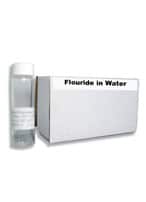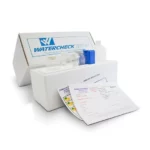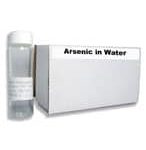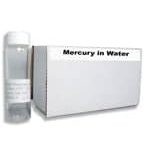Fluoride Water Test Kit
$49.95
Description
Fluoride in Drinking Water Test Kit
Simply fill the vial with water and mail to our lab. In seven to 10 days you’ll receive a written report with your results and how they stack up against the EPA’s maximum contaminant level for flouride. This test conforms to the EPA’s "National Environmental Laboratory Accreditation Conference," or NELAC standards for sensitivity and accuracy.
Fluoride Test Kit

Why You Should Not Consume Fluoride
With this test you can you can test for fluoride levels in your drinking water. Use it to see how well your water filter is at removing these poisons from your water. If you know that your water is being fluoridated and you still don’t have a fluoride pre-filter to filter your tap water then we recommend that you read the reports on this page showing alarming reports of fluoride being linked to bone cancer and other health problems. This test will begin to give you a reaction when the sample water has 2 parts per million of fluoride as indicated on the strip you will receive with your kit. When we tested our water we did not get a reaction, so this means that our tap water has less than 2 ppm. The EPA has set 4ppm of fluoride as the maximum contaminant level MCL). We have added important information about fluoride from the EPA website for your convenience, but the link in also provided for you to visit the site directly. Please read the other reports on the health effects of drinking to much fluoride in drinking water.
Basic Information about Fluoride in Drinking Water
https://www.epa.gov/ogwdw000/contaminants/basicinformation/fluoride.htmlWhat are fluoride’s health effects?
Some people who drink water containing fluoride well in excess of the maximum contaminant level (MCL) for many years could get bone disease (including pain and tenderness of the bones); children may get mottled teeth.
This health effects language is not intended to catalog all possible health effects for fluoride. Rather, it is intended to inform consumers of some of the possible health effects associated with fluoride in drinking water when the rule was finalized.
How is fluoride regulated?
In 1974, Congress passed the Safe Drinking Water Act. This law requires EPA to determine safe levels of contaminants in drinking water which do or may cause health problems. These non-enforceable health goals, based solely on possible health risks and exposure over a lifetime, are called maximum contaminant level goals (MCLG). Contaminants are any physical, chemical, biological or radiological substances or matter in water.
The MCLG for fluoride is 4 mg/L or 4 ppm. EPA has set this level of protection based on the best available science to prevent potential health problems.
What are EPA’s drinking water regulations for fluoride?
EPA has set an enforceable regulation for fluoride, called a maximum contaminant level (MCL), at 4 mg/L or 4 ppm. MCLs are set as close to the health goals as possible, considering cost, benefits and the ability of public water systems to detect and remove contaminants using suitable treatment technologies. In this case, the MCL equals the MCLG, because analytical methods or treatment technology do not pose any limitation.
EPA has also set a secondary standard (SMCL) for fluoride at 2 mg/L or 2 ppm. Secondary standards are non-enforceable guidelines regulating contaminants that may cause cosmetic effects (such as skin or tooth discoloration) or aesthetic effects (such as taste, odor, or color) in drinking water. EPA recommends secondary standards to water systems but does not require systems to comply. However, states may choose to adopt them as enforceable standards. Tooth discoloration and/or pitting is caused by excess fluoride exposures during the formative period prior to eruption of the teeth in children. The secondary standard of 2.0 mg/L is intended as a guideline for an upper boundary level in areas which have high levels of naturally occurring fluoride. It is not intended as a substitute for the lower concentrations (0.7 to 1.2 mg/L) which have been recommended for systems which add fluoride to their water. The level of the SMCL was set based upon a balancing of the beneficial effects of protection from tooth decay and the undesirable effects of excessive exposures leading to discoloration
This information was taken on 1/17/10
You can visit the EPA site for the latest updates they may have made to this information
====================================
Notice These Other Reports On Fluoride Below:
VIDEO: Alex Jones Interviews Dr. Neil Carman on Water Fluoridation This is a very compelling interview with Dr. Neil carman giving some eye popping details of fluoride. You must see this. Click here
https://www.youtube.com/watch?v=jzWQkhvOmbg&feature=PlayList&p=9C53F5B55EE0AED3&playnext_from=PL&playnext=1&index=11
Reuters: Another Study Links Fluoride to Bone Cancer
This news report shows that blood fluoride levels were significantly higher in patients with osteosarcoma than in control groups, according to research published in Biological Trace Element Research (April 2009). Osteosarcoma, a rare bone cancer, occurs mostly in children and young adults.
Human and animal cancer evidence prompts review of fluoride This article reports that California EPA committee designates fluoride as priority for review for public warnings about risk of cancer to consumers over the objections of the powerful lobbyists for the American Dental Association and the Personal Care Products Council who oppose further evaluation of fluoride as cancer-causing.
Fluoride Test Kit Details
The fluoride test is especially suited for rapid control of fluoride concentrations. Its purpose is to define concentration ranges and detect values which fall short of or exceed given limits.
Color Reaction:
The pink test disc is bleached by fluoride containing hydrochloric acid solutions. The size of the bleached area corresponds to the total fluoride concentration.
Fluoride Test Kit Contents:
3 test discs
1 bottle Chlorine/Fluoride test solution (hydrochloric acid)
1 disc color scale,
1 pin/needle,
Fluoride Test Instructions:
1. Fill a 20ml (beaker/small plastic container) about half-way with the water sample (about 10ml)
2. Add 20 drops hydrochloric acid. The pH value must be below 1.
3. Remove one fluoride test disc from ziplock bag. Close bag immediately.
4. Pierce the round test disc in the middle with the enclosed needle!
5. Throw test disc into the water sample and submerge completely.
6. after 5 – 7 minutes the test disc is saturated with the solution, i.e. it does not absorb any more liquid. At the latest 2 minutes after saturation remove the test disc from the sample and compare the size of the bleached zone with the disc color scale. This test will give you a reaction when the sample water has at least 2 parts per million of fluoride. Otherwise no changes will be observed.

For high concentrations the sample has to be diluted. After evaluation the dilution has to be taken into account.
Storage:
Avoid exposing the sticks to sunlight and moisture. Store the kit below + 30 degrees centigrade in a dry place.
Additional information
| Weight | 1 lbs |
|---|









Reviews
There are no reviews yet.